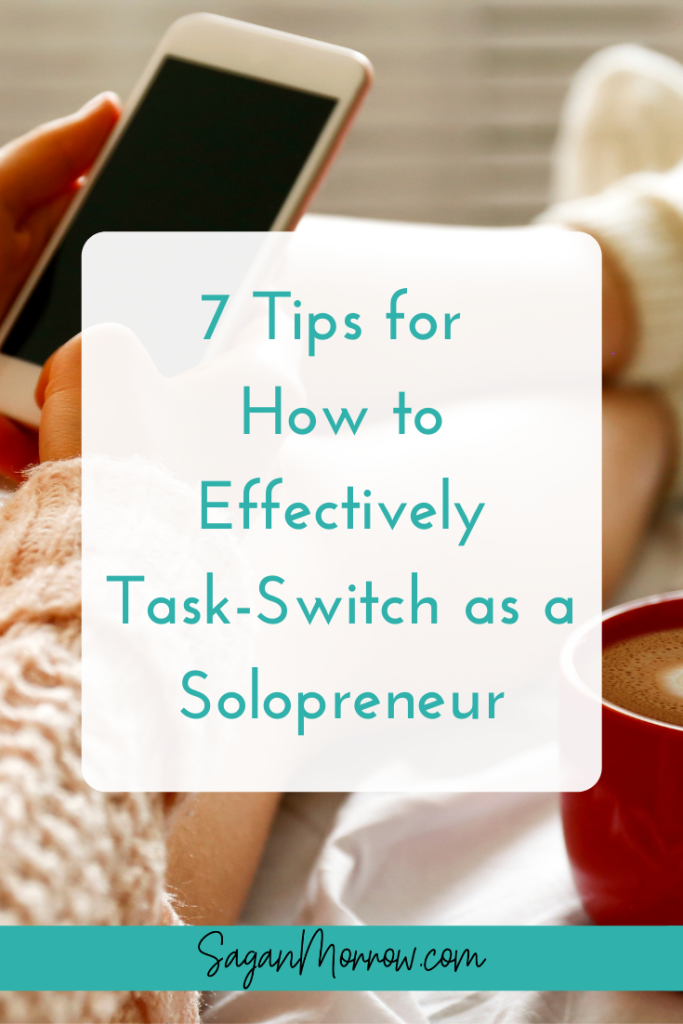Wondering how to switch tasks effectively? Effective task switching is a skill that every multipassionate can benefit from mastering! And as a solopreneur, you likely wear a lot of hats and juggle many different tasks and projects simultaneously… So the more that you can learn how to switch tasks effectively, the more productive you’ll be—without the hustle and burnout, of course 😉
This originally appeared as an episode on the Indie Author Weekly podcast. Tune in to learn about how to effectively task-switch between doing regular work and writing a novel, or keep reading to get 7 tips for how to switch tasks effectively as a solopreneur…
There are some practical ways that we can make task-switching a little more manageable, and improve our focus and productivity with it all. And since I’m an anti-hustle Productivity Strategist, this question is exactly the kind of thing I love!
Here are 7 tips for handling this problem around task-switching…
Tip #1: Stretch your creative capacity.
When you struggle with task-switching, it’s because your brain is already at max creative capacity. It means you’re too distracted, mentally, to focus on the next task at hand.
The key here is to identify what distracts you the most, and minimize those distractions. For example, when there are physical distractions in my environment, it distracts me mentally, too. So by cleaning the physical environment around me, I automatically clear up brainspace for creative purposes.
Something else I find really helpful is to find a song that I love, and play it on repeat. That’s a good strategy if you’re the kind of person who likes having sound on in the background, but it’s not distracting at all because it’s the exact same thing on a loop. Your brain doesn’t get distracted by a new melody starting every few minutes: Instead, it’s just the same thing over and over. If you choose an energizing song that inspires your creativity, then all the better.
And that brings us to the other side of this concept around increasing brain capacity for creativity: After you identify distractions and then minimize those distractions, you then want to identify what motivates you the most, and leverage those motivations. As in this example, with music playing in the background.
Basically, the idea here is that you’re trying to flex your creative capacity limitations. It’s easier to switch between tasks if you have the mental capacity for focusing, and you can stretch that capacity by minimizing distractions and leveraging your motivations.
One of the foundational pieces I teach inside my Productivity Powerhouse e-course is all about how to maximize our creative energy, and how to boost it when we find it slipping.
You can learn more about that program and enroll at SaganMorrow.com/powerhouse.
Tip #2: Don’t be afraid to adjust your processes.
Think outside the box: If you always use the same processes in your business, then what can you tweak or do slightly differently, that could have a big impact? This will be different for everyone, given your learning style, life situation, schedule, etc.
For example, what can you do to streamline your systems, improve your task management, or approach your work with a new perspective? Focus on one piece at a time so it doesn’t overwhelm you and break a large project down into smaller tasks that you can zero in on.
Tip #3: Make good use of reframing.
The concept here is to change your approach from a mental perspective. Your thoughts are within your control, so if you find that you get frustrated with your lack of progress, or if you get overwhelmed easily, then reframing the situation into something that motivates you, excites you, and brings you joy will dramatically improve your productivity and your end results.
Reframing is a very powerful tool for productivity, and it can absolutely apply to this situation. This is something I teach inside Productivity Powerhouse, so again, you can visit SaganMorrow.com/powerhouse to access the lessons and action steps for how to effectively reframe in your personal life or professional life
Tip #4: If at all possible, explore ways to get ahead on some of your other obligations so you can block off time for focusing on different tasks and projects.
Think about this in terms of both professional tasks and personal tasks. 
Can you do meal planning and meal prep for the week ahead, so that rather than cooking meals every day, you know exactly what you’ll be eating and you can use that saved cooking time to instead focus on completing a project? What professional tasks are taking up unnecessary amounts of your time, and could be put on pause or removed altogether?
Even when we think that we’re really good at getting ahead on things and batching stuff, there are ALWAYS more things we can do and improve upon. And again, I say this as a Productivity Strategist—I am continuing to identify more things I can improve on in my own life and business!
So take a step back, take a really good look at your current situation, and assess it honestly from an outsider perspective. Where can you get ahead on a few things so you can block off future time for your project? There will often be things that we identify but we don’t have the capacity to deal with right now—so in that case, go for the low-hanging fruit and the stuff that is easiest for you to get ahead on.
Tip #5: Give yourself the space to do some “mental work.”
This is one of my favourite activities. I often do this when I’m out for a walk, or when I’m lying in bed and can’t fall asleep at night. Other people might want to use shower time to do this. The idea here is that you’re giving yourself free rein, mentally, to think about your task or project. You’re doing some “work” in your head by mulling it over, outlining it, planning in advance, and so on.
Some of the most incredible ideas and pieces of writing can occur when you aren’t sitting in front of the computer. Because you’re removing the pressure.
Now, while you’re doing this mental work, you might get some awesome ideas that you want to write down. Awesome! Do that. Jot down bullet points or anything that comes to mind.
Thinking time is super important for every business owner. We often don’t prioritize this because it’s not quantifiable, and because it feels hard to justify giving up time to think rather than have tangible action steps and results. But when we prioritize time to think, that is where so much of the real progress is made. It gives you a little kickoff for the creative energy.
Tip #6: Focus on small, consistent progress of tasks.
Spending 15 minutes/day on a bite-sized task and making forward progress is much more doable when you do it every single day. By doing this, you don’t have to reach as far back in your mind to figure out what you did last time and where you need to pick up the task from here, for example.
Task-switching is less of an issue when your task/project is always fresh on your mind, every day, so it doesn’t take as much energy or time or creativity or brainspace to switch between tasks.
Getting into this can sometimes take a little adjustment period, so if you can set aside closer to 30 minutes for the first few days, that’ll make it easier for you to get into the swing of things with 15-minute blocks the following days and moving forward.
Tip #7: Don’t make a bunch of changes all at once to your routine.
If you decide to make task-switching easier on yourself by doing small amounts of progress every day, then it will be even easier if you add it as part of your routine. But it’s important not to add it to your routine if you recently added a bunch of other things to that routine! Your energy capacity will get overwhelmed.
Add to your routine slowly, one at a time, or during a season when you don’t have a bunch of other life and business changes happening. And make it manageable: Set the timer for 15 minutes per day, for example. You don’t need to do tons of work in a big chunk.
So, those are my 7 tips for how to manage task-switching between writing fiction and doing other things.
Ready to learn a ton more about how to improve your focus, increase your productivity, and get more done in less time—without the overwhelm?
Join my signature self-study program, Productivity Powerhouse.
To recap today’s tips:
- Identify & minimize distractions, and then identify & maximize motivations, to increase your creative capacity in your brain
- Think outside the box and adjust your processes
- Make good use of reframing
- Explore ways to get ahead on other things in your personal or professional life, so that you CAN block time off for all the tasks you want to do
- Give yourself the space for thinking time, so you can do “mental work”
- Focus on small, consistent, daily habits
- Add it as part of your routine, during a time in your personal & professional life when you aren’t also dealing with a bunch of other changes
